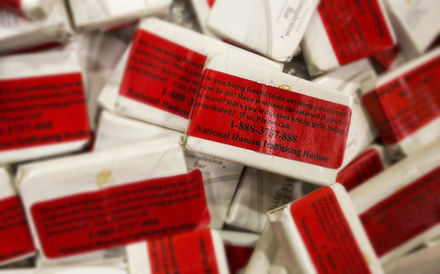A 16-year-old girl boarded a bus in Eden Prairie, Minnesota, on her way to meet a 21-year-old Sierra Vista man who had asked her to send him nude photos.
Matthew Lyons called the girl a “ho” and threatened to beat her if she didn’t call him “daddy,” according to text messages included in a criminal complaint filed in federal court in Tucson.
The girl ran away from a group home in January 2016 and used a ticket Lyons bought for her to board a bus to Arizona, an FBI agent wrote in the complaint. The girl and Lyons had arranged for her to have sex for money in exchange for a place to stay in Sierra Vista.
But the friends who gave her a ride to the bus station in Eden Prairie called the police and officers found her at a transfer station in Minneapolis.
If police hadn’t found her, the girl could have “suffered the same fate” as the victim in a state court case where Lyons was charged with a similar crime, federal prosecutor Raquel Arellano wrote in a sentencing memorandum.
In June 2016, Lyons coaxed a 31-year-old Utah woman to Sierra Vista. She told detectives Lyons sexually assaulted her for several days before a friend called the police, the Sierra Vista Herald reported. She said Lyons forced her to get a tattoo reading “Property of Matt D. Lyons” on her chest.
Lyons pleaded guilty to a child sex-trafficking charge in the case of the Minnesota girl. He was sentenced in September to 10 years in federal prison. He also pleaded guilty to aggravated assault and robbery in Cochise County Superior Court in the case of the Utah woman, records show. He was sentenced to five years in prison, which will run at the same time as his federal sentence.
The Minnesota girl’s friends likely saved her from becoming a victim of sex trafficking of children, a crime that occurs across the country and around the world. Sex trafficking of men, women, and children is second only to drug trafficking in terms of profits from transnational crime, according to the Department of Homeland Security.
In recognition of that , January is National Slavery and Human Trafficking Prevention Month. In Tucson, January also means the arrival of the gem show and hotels booked to capacity along Interstate 10. Events that draw large out-of-town crowds, such as the gem show or the Super Bowl, are “absolutely going to be a draw for traffickers,” said Tucson police Detective Jennifer Crawford.
Tucson police didn’t see a spike in reports of sex trafficking during last year’s gem show, “but that’s not to say it’s not happening,” said Crawford, who is a member of the Southern Arizona Anti-Trafficking United Response Network.
In addition to patrolling gem-show sites, Tucson police are asking hotel employees to stock bathrooms with bars of soap that have a phone number that sex-trafficking victims can call for help, she said.
Numbers of child victims remain unclear
Sex trafficking of children has gained attention in recent years and federal lawmakers targeted websites they believed facilitated it, but the number of children who become victims of sex traffickers remains unclear.
Arizona State University researchers led by Dominique Roe-Sepowitz sought to fill the knowledge gap in a 2017 report. They analyzed news reports and court records from 2010 to 2015 and found 1,416 traffickers involved in 763 cases of sex trafficking of children nationwide.
Arrests of child sex traffickers jumped from 97 in 2010 to 360 in 2015 nationwide, which the ASU researchers said could be due to increased training of local police and social-service workers to identify victims.
During the same period, reports of suspected child sex trafficking rose 846 percent, Yiota Souras, vice president of the National Center for Missing and Exploited Children, testified to the U.S. Senate.
Tucson police reported seven total cases in 2015 and 2016 of sex trafficking of children, along with 69 cases involving adults, according to a report from the Office of Sex Trafficking Intervention Research at ASU.
Statewide, 30 law enforcement and social-service groups reported 560 cases of child sex trafficking for those two years and 1,777 cases of adult sex trafficking.
Runaways targeted
As was the case with the Minnesota girl, runaways made up more than half of the victims in the nationwide cases of sex trafficking of children found by the ASU researchers.
In Tucson, a 13-year-old girl ran away from a group home in April 2017 after she was bullied. While walking down the street, she met Maximino Matas-Cranz, 19, who told her she could stay at his apartment, Deputy County Attorney Tracy Miller told a jury Wednesday as Matas-Cranz’s trial began in Pima County Superior Court.
The first night at the midtown apartment, Matas-Cranz played video games while the girl slept on a pull-out couch, Miller told the jury.
But the next day, Matas-Cranz grabbed her by the arm, took her into the bathroom, locked the door, and told her to get undressed, Miller said. After sexually assaulting her, “He gets out of the shower and leaves her lying on the bottom of the tub,” Miller said. The girl had nowhere else to go, so she went back to the couch.
The next day, Matas-Cranz said he needed money and told her he intended to “put her on the corner,” Miller said. He told her she needed to get a tattoo, dye her hair and get new clothes.
After going to a thrift store, they returned to the apartment, where Matas-Cranz struck her when she told him her period had started, Miller said. The girl hid in the bathroom but knew she had to leave. She left the apartment and asked a neighbor to call the police.
Matas-Cranz was arrested and charged with the sex trafficking of a minor, kidnapping, sexual assault of a minor and aggravated assault of a minor.
On Wednesday, defense lawyer Rachel Lynn Stewart said the girl’s account “continues to change” and she was “free to come and go as she pleased.”
Stewart also said there was no DNA showing Matas-Cranz and the girl had sex. Instead, the girl smoked marijuana and began to act strangely, which got the attention of a neighbor, who called the police, she said.
Statewide, more than 300 children were classified by the Department of Child Safety as runaways from group homes or foster care as of June 2017. Codac, which is part of Southern Arizona’s Anti-Trafficking Network, reported helping nine child-trafficking victims who were involved with DCS since late 2015.
In a survey of 215 homeless young adults in Arizona, 36 percent identified as victims of sex trafficking, according to the 2016 annual report from the Arizona Human Trafficking Council.
Online trafficking
While the Matas-Cranz case involved a chance meeting on the street, lawmakers and researchers point to online classified advertisements as a major facilitator of sex trafficking of children.
The ASU researchers found the website Backpage.com was used in 42 percent of the cases they found from 2010 to 2015. A January 2017 Senate report said 73 percent of child-trafficking calls from the public involved the Backpage.com website.
Traffickers advertised their victims on the website by using words such as “lolita,” “amber alert,” and “fresh,” according to the Senate report.
Those ads played a role in a June 2016 case that began near Benson when a state trooper pulled over a sedan on Interstate 10.
The trooper couldn’t verify the identity of one of the passengers, a girl who said she was 19. The trooper ran her name through a national database and found a runaway juvenile alert for a California girl who was around 16 years old at the time.
The girl said she was the runaway but “begged the trooper not to tell the others of her real identity,” an FBI agent wrote in a criminal complaint filed in federal court in Tucson.
The girl said Derek Terry, 28, approached her in a convenience store in San Bernardino, California, two weeks earlier and they exchanged phone numbers. She said she did not tell him her true age.
The trooper found images of the girl and two women, ages 22 and 24, who also were in the car with the girl and Terry, in ads for escort services on Backpage.com.
Agents said Terry took the girl to Mesa and El Paso, where she had sex for money with men who responded to the website ads. Terry later said he had taken the girl from a “gorilla pimp” in California, a slang term for a violent pimp.
Terry pleaded guilty in August to three sex-trafficking charges. He faces 14 to 20 years in prison at his Feb. 23 sentencing hearing in federal court in Tucson.
“Frozen” doll
for Mexican girl
Despite the flow of illicit traffic across the U.S.-Mexico border, court records show few Southern Arizona cases of sex trafficking involving Mexican children.
In a rare example, FBI agents arrested a Tucson couple in February 2017 after Linda Rodriguez, 41, arranged for a 15-year-old Mexican girl to travel to Tucson to have sex with her boyfriend, Randall Velasquez, 52, for $500.
Rodriguez contacted a confidential source for the FBI in late 2016 and asked for photos of girls between the ages of 13 and 16 years old, according to a criminal complaint.
The girls had visas so they could legally cross the U.S.-Mexico border. Rodriguez told the source that Velasquez wanted one of the 15-year-old girls in the photos, according to text messages recovered by FBI agents.
In February 2017, Rodriguez and Velasquez showed up at the designated meeting place to pick up the girl. Inside Velasquez’s truck were condoms, $1,000 and a doll from the Disney movie “Frozen” as a gift for the girl.
Velasquez told investigators that Rodriguez was getting him a girl for his birthday, but he claimed he told Rodriguez the girl had to be over 18. Rodriguez pleaded guilty in November to one count of attempted sex trafficking of a minor. Under the plea agreement, she will be sentenced to 10 years in prison. She is to be sentenced in June. Velasquez’s trial is scheduled for Feb. 13.





